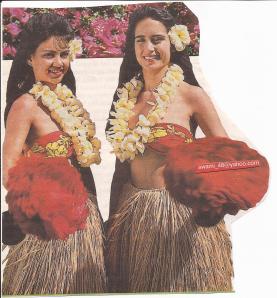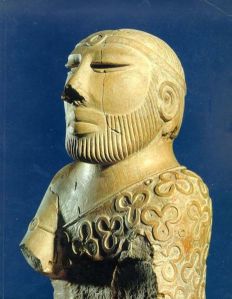
Women of Hawaii with Reed Skirt
(Tamil version of this article is posted in two parts with references: London swami)
Sangam Tamil literature sings about the reed skirts of Tamil women. The skirts were made up of dried grasses or reeds. I was looking for such dress in the sculptures and paintings, but in vain. Recently I came across such reed skirts worn by women of Hawaii. Even today women in Pacific islands wear such reed skirts. While I was reading a book on the customs during the age of the Brahmanas (part of Vedic literature), I read another interesting fact. Brahmin priests were wearing reed skirts made up of certain types of grass for the Yagas (fire ceremonies).
The Priest-King of Indus valley civilization wears an embroidered shawl. Incidentally Brahmana scriptures mention embroidered woollen cloths. Tamils also wore dress with flower designs on it, says 2000 year old Purananuru (274).
Silappadikaram is the most popular Tamil epic that sings the glory of ancient Tamil kingdoms. Adiarkku Nallar, one of the commentators, gives 36 types of Tamil clothes. Their names include clothing imported from Malaysia, Burma, Orissa and Gujarat ( all the 36 types are given in my Tamil version of this article).
Nakkirar, one of the famous poets of Sangam period, says that “we need one Nazi measure of food every day, two pieces of clothes. It shows the ancient Tamils wore one upper garment and one under garment like Dhoti. We have descriptions of shirts called ‘Kanchukam’, mostly worn by soldiers or foreign body guards from Rome (Yavanas=Milechas). Those Milechas were described as speechless, dumb and men of gestures (sign language)—Mullai Pattu lines 66-67.
One great thing about the Tamils was that they produced cloths looking exactly like a snake skin. Ancient Egypt was believed to have imported all the clothes for the mummies from Tamil Nadu. When we look at the Tamil name of the Egyptian God of weaving ‘Neith’, we have to accept the fact that Tamils were the main source of clothes for Egyptian Pyramids.
The clothes that looked like a snake skin were praised by many Tamil poets in the Sangam anthologies. A verse in Akananuru describes a wedding scene. The bridegroom noticed that bride was sweating under her sari. When he took off her sari to let some air, she looked like a shining sword out of its sheath. His real intention was to have a look at her beautiful face. She tried to hide her body with her hair and the garlands as soon as he took her clothes off. This verse throws some light on the type of clothes (may be saris) they wore during weddings.
Andal ,a poetess who lived in the seventh century AD describes about a wedding sari called Kooraip Pudavai. This type of sari, red in colour, is still used by the Brahmin ladies on the wedding day.
REED DRESS reference from the Vedic Literature:

Picture shows Indus priest king with embroidered shawl.
From “India of the age of the Brahmanas” by Jogiraj Basu
‘’garments made up of wool, cotton and silk were worn by the people. Cotton and wool, sewing and knitting are often referred to. The term sutra refers to cotton and urna to wool which was made up of sheep’s hair. The general dress consisted of three parts—the main portion fitting the body called vaasa, an outer or over garment called aadhi vaasa and an under garment named niivi.
Warp, woof and different aspects of weaving are referred to in SB 3-1-2-18.
Suvaasa (good garment) and suvaasaa (well clad) occur frequently in SB and AB etc.
“ garment is a man’s outward appearance, whence people on seeing a well clad man, asks who can this be? for he is perfect in his outward appearance.” (SatapataBrahmana)
When a cloth is woven it is embroidered at the border before the actual texture is woven; it is embroidered in the middle and again it is embroidered at the end” (Aitareya Brahmana 2-11-10)
Special garments were prescribed for the priests performing sacrifice. Skirts made up of Kusa grass were used in certain sacrifices. From the S.B. we learn that the sacrificial garment consisted of a garment of pure wool not dyed, an under garment made of silk called “taarpya”, an outer garment like adhi vaasa and a head dress or turban (Usniisa). Kings and queens wore such head dress. Indra’s wife Indrani had a most variegated (multi coloured and embroidered) head band, says S.B. 14-2-1-8
Sages, mendicants and Brahmacharis used to put on garment made of hides of black antelope (krsnaajina).
Female ascetic Sabari in the Ramayana was called Krishnaajinaambharadharaa i.e. one who puts on the garment made of black deer skin.
Sanskrit dramas describe the red colour dress of the prisoners who were sentenced to death.
Tamils designed the first Bra (ssiere)?
World Tamil souvenirs and Tamil magazines show ancient Tamil women wearing bra. There is a convention of drawing or painting Tamil women like this for hundreds of years. But we don’t see such a custom or costume in any other ancient civilization. They did not wear brassiere. Neither did the Tamil women in ancient paintings at Sithannavasal or temple sculptures. They were shown with bare breasts. Not even in Ajanta paintings in Maharashtra. But the Tamil convention of drawing or painting women with bras made me think that Tamils should have designed it first. But it needs more in depth research on the origin of Bras.
*****************
